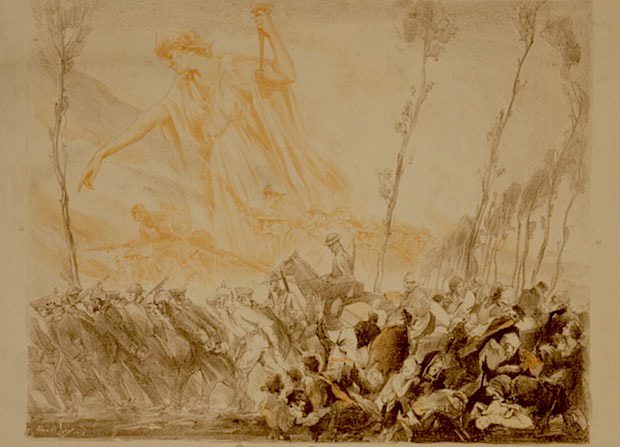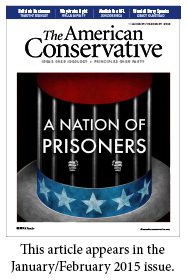America’s Home-Made Art

Niveous? I’ll say.
Thirty miles to our west enough snow has fallen to bury LeBron James, but neither snow nor rain nor cover charge could keep us from visiting “Alexander O. Levy: American Artist, Art Deco Painter,” a welcome exhibit dedicated to the German-born, Ohio-bred Buffalo illustrator, regionalist, and cranky reactionary of the Queen City.
Though lauded in prewar Europe as an unusual Art Deco/traditionalist hybrid, Levy (1881-1947) was staunchly cisatlantic, explaining, “I have never felt the need of travel for inspiration. In my opinion, an artist can find enough that is beautiful and interesting to paint within a block of his home.”
Clearly Levy was a man of boundless imagination, in the fashion of Bernard DeVoto, who asked the unanswerable question, “Why see Paris, France, if you haven’t seen Paris, Illinois?”
(DeVoto, who is almost as forgotten as Levy, was also an old-fashioned American. He publicly defied the FBI when such an act took guts—during the Truman-era Red Scare—writing in Harper’s, “I like a country where it’s nobody’s damn business what magazines anyone reads, what he thinks, whom he has cocktails with.” What a quaint notion.)
Fittingly, Buffalo is celebrating Alexander Levy in the Burchfield Penney Art Center, whose half-eponym, the watercolorist Charles Burchfield, was another Buckeye boy gone Yorker. Across the street is the Albright-Knox Art Gallery, which Levy despised for its “class bias,” its pious modernism, and for ignoring Buffalo artists, captive as the gallery was to the debilitating and specious belief, so common among the provincial culturati, that nothing good can come from local soil, and that truth and beauty are always somewhere over the rainbow, to borrow a line from another Jewish Buffalonian, Harold Arlen. Littering the Albright-Knox’s grounds today are banal sculptural hulks just begging for a witty graffitist or a spirited youth with a can of spray paint.
Subject-wise, Alexander Levy was partial to dimly lit landscapes, bustling Buffalo street markets, and languid ladies in varying states of dress and repose. Levy’s 1930s work sits near the door of the Regionalist school of Grant Wood and John Steuart Curry, and like those agrarian romantics he was appalled by the eclipse of representational art by the abstract—the inhuman. (Others call it “CIA art,” an appellative nod to the covert support the well-bred Yalies of the nascent national security state gave to Abstract Expressionism during the Cold War. See Frances Stonor Saunders’s Who Paid the Piper? for the artfully told story. Most amusing is the central role of Tom “Eight is Enough” Braden, the smug middlebrow who was so proud that he had heard of Jackson Pollock and your grandmother hadn’t. Just think: the international aesthetic reputation of our country was manipulated by a man convincingly personated by Dick Van Patten.) 
Abstraction, Charles Burchfield dolefully conceded in a 1959 interview, had triumphed, and “all you can hope is that the artists will sometimes again turn their attention back to humanity and the world of nature. How it’s going to be done I wouldn’t have any idea.” Alexander Levy’s idea was to organize a Buffalo chapter of the primly named Society for Sanity in Art, an act that lubricated his trip down the memory hole.
There are few cultural tasks nobler—or more enjoyable, at any rate—than pulling the likes of Levy out of their holes and into the sunlight. Every block, every hamlet, every American city has an Alexander O. Levy. Dig ’em out.
Make reclamation a vocation.
When my wife and I repatriated to my hometown half a lifetime ago, I announced to my befuddled friends in Washington that I was going to be the Hamlin Garland of the Burned-Over District, an ambition unlikely to draw much competition.
Garland was a late 19th-century writer out of the Upper Midwest. An innocent with a vision, Garland was a fanatical autodidact, a fervid Populist Party man, a prude who took an especial scunner to bathing suit ads in the newspaper. Late in life he sold out, abjectly, but I loved him for his 1894 manifesto Crumbling Idols, in which he exhorted Americans of the hinterlands to reject the straitjackets of Boston and New York.
“Each locality must produce its own literary record,” wrote Garland. “I am a Western man… I want to see its prairies, its river banks and couples, its matchless skies, put upon canvas. I want to see its young writers writing better books, its young artists painting pictures that are true to the life they live and the life they know. I want to see the West supporting its own painters and musicians and novelists … the Western writer must, above all other things, be true to himself and to his time.”
Alexander Levy painted the life he knew. Be true to your school.
Bill Kauffman is the author of ten books, among them Dispatches from the Muckdog Gazette and Ain’t My America.
Comments